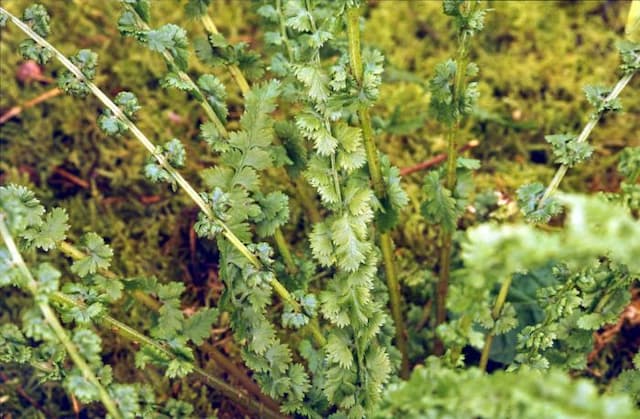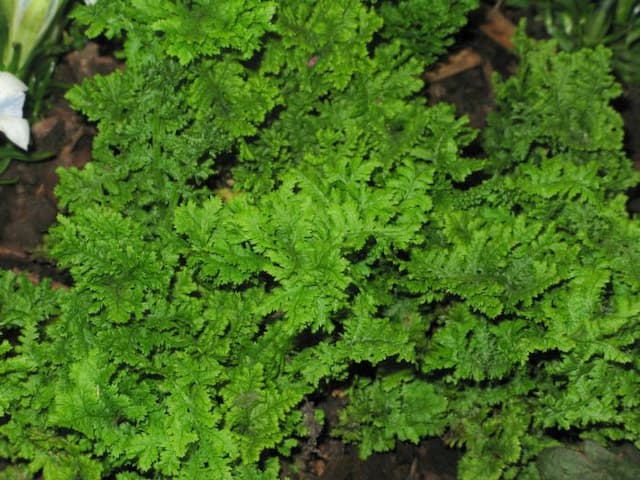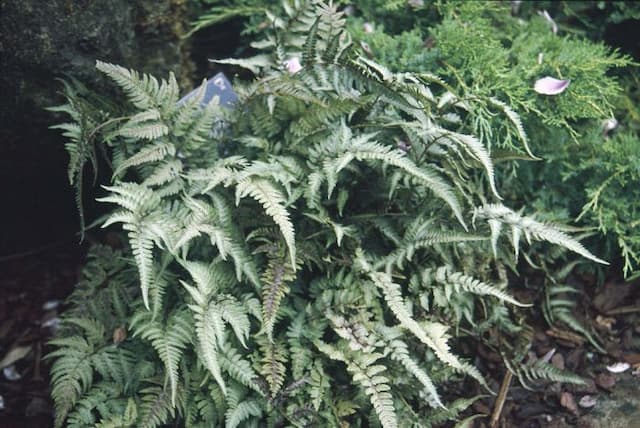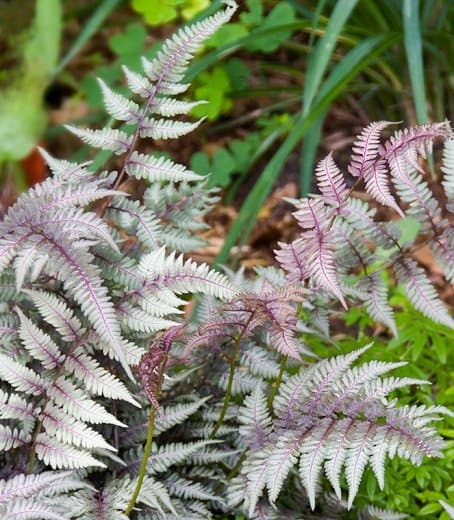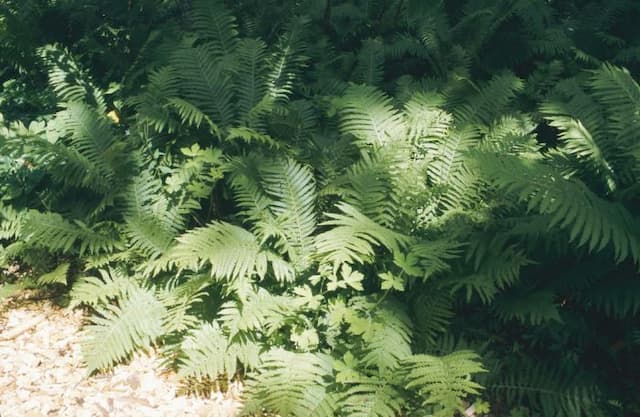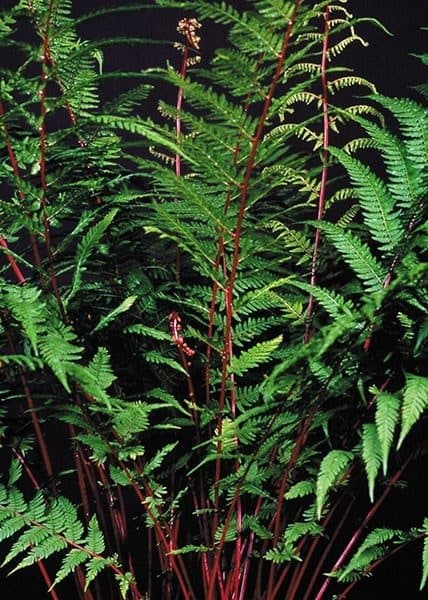Eared Lady Fern Athyrium otophorum var. okanum

ABOUT
The plant commonly known as the eared lady fern features a delicate and intricate appearance. It possesses a beautiful arrangement of fronds that are typically a lush shade of green, giving it a vibrant and lively presence. The fronds are characterized by a feathery, fine texture, contributing to the overall soft and graceful look of the plant. The individual leaves on the fronds, called pinnae, have a notable shape that somewhat resembles an ear, which is a distinguishing characteristic of this fern. The edges of these leaves are often slightly ruffled or serrated, adding to the detailed aesthetics of the foliage. As the eared lady fern grows, it forms a symmetric, clump-like structure composed of numerous fronds that elegantly arch out and downward. This creates a dense and layered effect, which is particularly striking in a shaded garden or woodland setting. While the plant itself is perennial, meaning it will come back year after year, each frond unfurls from a rolled-up state known as a fiddlehead, which is a whimsical and much-anticipated event in the lifecycle of the fern. The color and textures of the eared lady fern also change with the seasons. In the growing season, the fronds are fresh and bright green, while in the fall, they may turn to a more muted shade before the plant goes dormant in winter. The visual softness of the fern makes it an excellent companion to coarser foliage plants in a garden setting, allowing for a contrast that highlights its finesse. Overall, the eared lady fern presents a peaceful and natural elegance, which makes it an attractive choice for gardeners looking to add some woodland charm to their landscapes.
About this plant
 Names
NamesFamily
Athyriaceae
Synonyms
Eared Lady Fern, Auriculate Lady Fern
Common names
Athyrium otophorum var. okanum.
 Toxicity
ToxicityTo humans
Athyrium otophorum var. okanum, commonly known as the eared lady fern, is not typically known for being toxic to humans. There is limited information suggesting that any part of the eared lady fern is poisonous if ingested. However, as with many plants, it is generally recommended to avoid ingesting parts of ornamental plants due to the possible presence of irritants or the potential for allergic reactions in some individuals.
To pets
Eared lady fern (Athyrium otophorum var. okanum) is not known to be toxic to pets. There is no widespread evidence to suggest that ingesting parts of this fern will result in poisoning for household animals such as dogs and cats. As with humans, it is generally a good idea to prevent pets from consuming non-food plants, as they might cause gastrointestinal discomfort or potential allergic reactions, even if not considered poisonous.
 Characteristics
CharacteristicsLife cycle
Perennials
Foliage type
Deciduous
Color of leaves
Varies
Height
1-2 feet (30-60 cm)
Spread
1-2 feet (30-60 cm)
Plant type
Herb
Hardiness zones
5
Native area
Japan
Benefits
 General Benefits
General Benefits- Erosion Control: The root structure helps stabilize soil and prevent erosion on slopes.
- Habitat Support: Provides shelter and habitat for insects and small wildlife.
- Aesthetic Appeal: Adds visual interest to gardens with its unique foliage.
- Low Maintenance: Requires minimal care once established in suitable conditions.
- Diversity: Contributes to the biodiversity of a garden ecosystem.
- Shade Tolerance: Thrives in shaded areas where other plants may struggle.
 Medical Properties
Medical PropertiesThis plant is not used for medical purposes.
 Air-purifying Qualities
Air-purifying QualitiesThis plant is not specifically known for air purifying qualities.
 Other Uses
Other Uses- Crafting Natural Dyes: Eared Lady Fern can be used to create natural dyes for textiles, yielding a range of colors depending on the mordant used.
- Ornamental Pressed Plants: The delicate fronds of Eared Lady Fern can be pressed and used in botanical art and crafts, such as in framed plant art or handmade greeting cards.
- Garden Path Lining: This fern can be planted alongside garden paths to provide a lush, green border that enhances the visual appeal of garden walkways.
- Educational Tool: This plant can be an excellent subject for botany education, as students can learn about fern reproduction, lifecycle, and spore patterns.
- Culinary Garnish: While not a common edible, the fronds of Eared Lady Fern may be used as a decorative, non-toxic garnish for plating and presenting dishes.
- Photography Subject: The unique structure of the Eared Lady Fern makes it a fascinating subject for photographers, especially those specializing in plant and macro photography.
- Contemporary Landscaping: Landscape architects can use Eared Lady Fern in modern landscape designs to create contrast with hardscapes and other architectural elements.
- Biodegradable Packing Material: Dried fronds can potentially be used as a natural and biodegradable packing material to cushion items.
- Fern Collections: Enthusiasts and collectors may cultivate Eared Lady Fern as part of a fern collection or specialty garden focusing on variegated plant species.
- Floristry: The fronds can be incorporated into floral arrangements as a filler or backdrop to add volume and texture to bouquets and centerpieces.
Interesting Facts
 Feng Shui
Feng ShuiThe plant Athyrium otophorum var. okanum is not used in Feng Shui practice.
 Zodiac Sign Compitability
Zodiac Sign CompitabilityThe plant Athyrium otophorum var. okanum is not used in astrology practice.
 Plant Symbolism
Plant Symbolism- Elegance: The Athyrium otophorum var. okanum, commonly known as the Eared Lady Fern, features delicate, arching fronds and a graceful growth habit, often symbolizing elegance and refined beauty.
- Solitude: Ferns are often found growing in secluded, shady forests and as such, they can represent a love for solitude and peaceful, quiet places.
- Secret Bond: Historically, ferns have been associated with secret bonds of love and hidden desires, due to their secluded growth habits and the ancient belief that ferns possess invisible seeds.
- Protection: In some cultures, ferns are said to offer protection and a sense of security, as they can create dense, sheltering thickets in the wild.
- Magic and Fascination: Ferns, due to their lush and prehistoric appearance, have been connected to the magical realm, symbolizing a fascination with the unknown and the wonders of nature.
 Water
WaterEared lady fern should be watered regularly to maintain evenly moist soil, particularly during the growing season. The frequency of watering may vary from once a week to several times per week, depending on the temperature and humidity levels. A general rule is to provide about 1 to 2 cups (8 to 16 ounces) of water per week, adjusting as needed to ensure the soil remains damp but not waterlogged. Avoid letting the soil dry out completely, and reduce watering in the dormant winter months.
 Light
LightEared lady fern prefers dappled shade or bright, indirect light. It should be placed in a location where it is protected from direct afternoon sun, which can scorch its delicate fronds. A spot near a north- or east-facing window or under the canopy of larger plants outdoors would provide ideal light conditions for this fern.
 Temperature
TemperatureEared lady fern thrives in temperatures between 60 and 75 degrees Fahrenheit, with the ability to withstand a minimum of 50 degrees Fahrenheit. Avoid exposing it to temperatures below 50 degrees Fahrenheit, as cold drafts and frost can damage the plant. Keeping it in a climate-controlled environment, such as a typical indoor setting, is ideal for maintaining consistent temperature conditions.
 Pruning
PruningEared lady fern may require pruning to remove any dead or damaged fronds, which helps to maintain a tidy appearance and encourages healthy new growth. Pruning is best done in the spring before new growth begins. This fern does not require frequent pruning; once a year is typically sufficient. Always use clean, sharp shears to make precise cuts.
 Cleaning
CleaningAs needed
 Soil
SoilEared Lady Fern thrives in a well-draining soil mix rich in organic matter with a pH of 5.5 to 6.5. A mixture containing peat moss, pine bark, and perlite or vermiculite would provide the necessary structure and acidity for optimum growth.
 Repotting
RepottingEared Lady Fern should typically be repotted every two to three years to refresh the soil and accommodate growth. The best time to repot is in the spring before the new fronds emerge.
 Humidity & Misting
Humidity & MistingEared Lady Fern prefers a high humidity environment, generally above 60%. To maintain optimal humidity, group it with other plants or use a humidity tray, but be cautious of overly wet conditions to avoid fungal issues.
 Suitable locations
Suitable locationsIndoor
Place Eared Lady Fern in bright, indirect light and ensure high humidity for optimal growth.
Outdoor
Plant Eared Lady Fern in shade to partial shade, moist soil, and shelter from wind.
Hardiness zone
4-8 USDA
 Life cycle
Life cycleAthyrium otophorum var. okanum, commonly known as Eared Lady Fern, begins its life cycle as a spore, which germinates to produce a small, heart-shaped gametophyte (prothallus). The prothallus, which contains both male and female reproductive organs, undergoes fertilization when water allows sperm to swim to the egg, resulting in a zygote. This zygote then develops into a new sporophyte, the familiar fern plant, starting as a small fiddlehead that unfurls its fronds as it matures. The mature fern produces spore cases (sori) on the underside of its fronds, which, when ripe, release spores to the environment, continuing the reproductive cycle. These ferns typically grow in moist, shaded forest environments and can reach maturity in a few growing seasons, with fronds dying back in the winter and regrowing each spring. As perennial plants, Eared Lady Ferns can live for many years, going through the process of spore production, growth, and dormancy annually.
 Propogation
PropogationPropogation time
Spring to summer
Propogation: The Eared Lady Fern, scientifically known as Athyrium otophorum var. okanum, is most commonly propagated through division. The best time to divide this fern is in the spring, just as the new fronds start to emerge. This method involves carefully taking the fern out of the ground or its container and gently separating it into smaller sections, ensuring that each section has a piece of the root system and at least one growing frond. The divisions can then be replanted in soil that is rich in organic matter, kept moist, and shaded initially to prevent shock. This technique allows the gardener to quickly increase the number of plants and achieve a more immediate impact in the garden or landscape setting.
